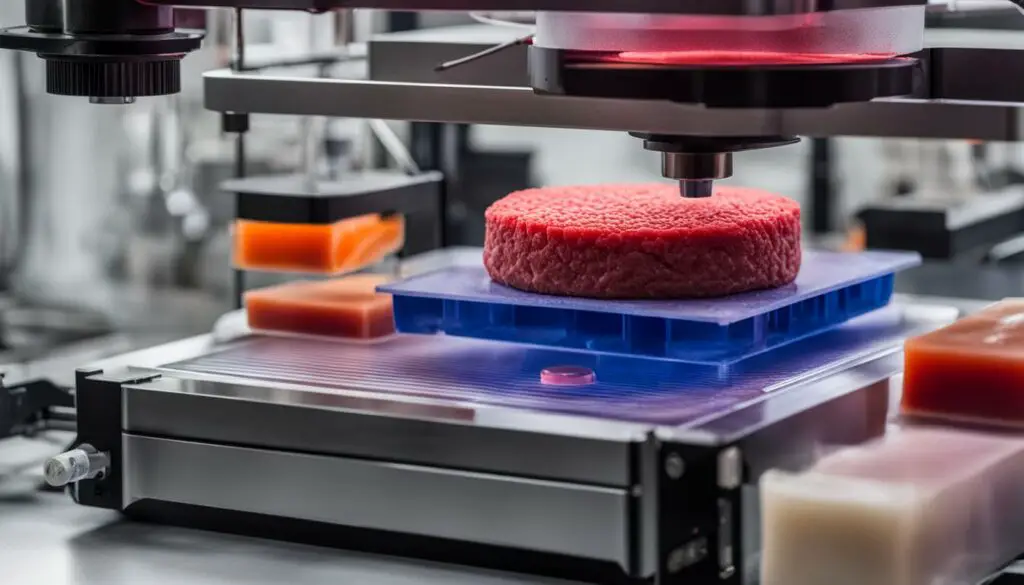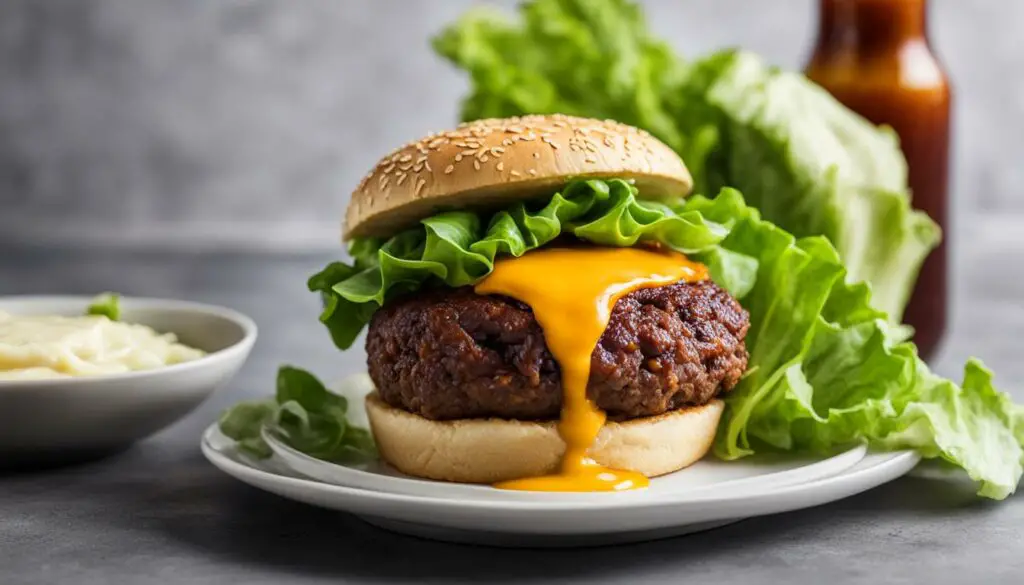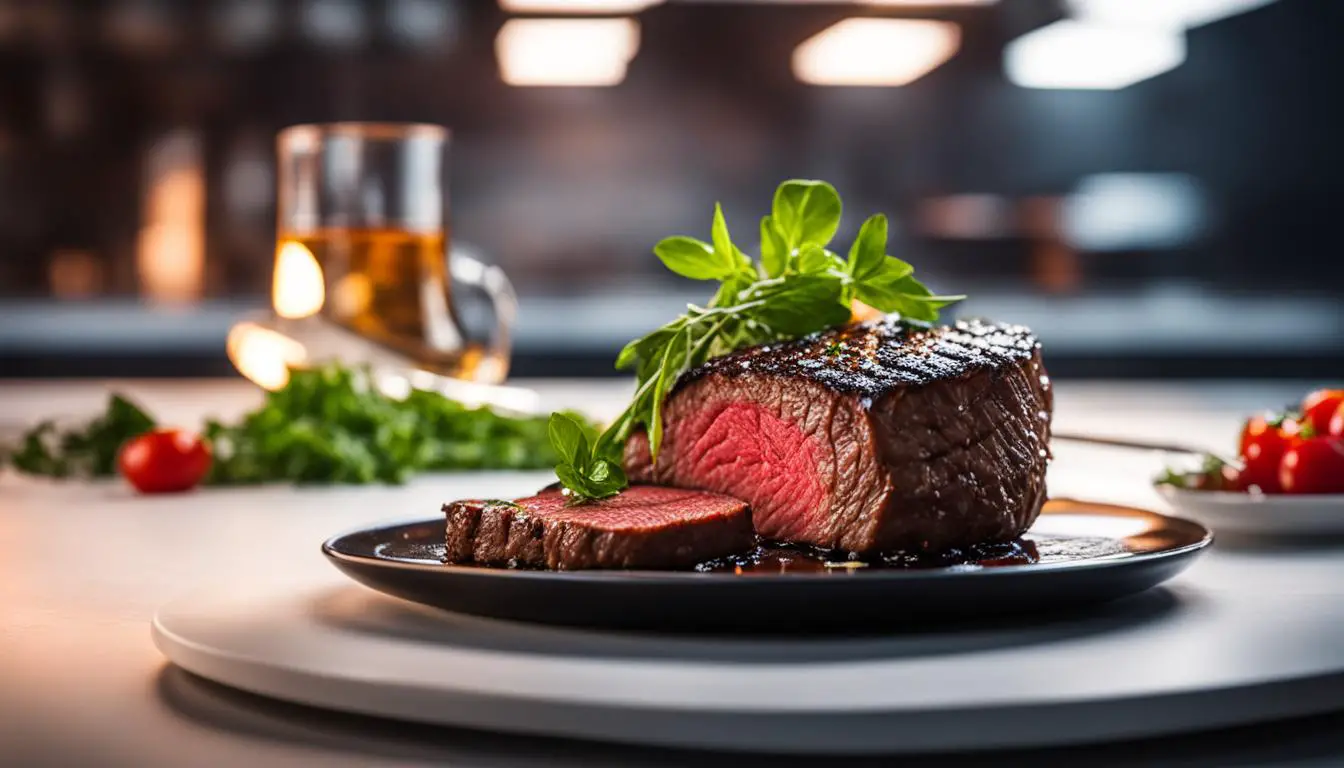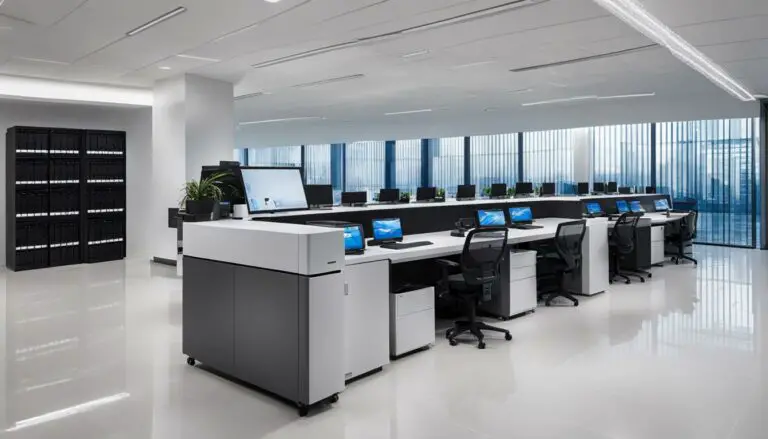The Debate Over 3D Print Meat: What You Should Know
Originally posted on December 4, 2023 @ 2:15 pm
In this article, we will explore the intriguing topic of 3D printed meat and the controversies surrounding it. Thanks to technological progress, researchers and creators can now produce food, including meat, through 3D printing. This revolutionary development has sparked significant debates about its potential impact on business and morality.
3D printed food, including meat, is gaining popularity across various industries such as restaurants, baking, and healthcare. The ability to customize the flavor, color, texture, and nutritional content of the food is an exciting prospect. However, it is crucial to examine the potential risks and benefits associated with consuming 3D printed meat.
Artificially produced meat, also known as lab-grown or cultured meat, is considered a protein alternative and a sustainable approach to meat production. It is often hailed as a futuristic food that could revolutionize the way we consume meat. However, this technology also raises important ethical and societal questions that need to be addressed.
Throughout this article, we will explore the science behind 3D printed meat, how it is used in different industries, and its potential environmental impacts. We will also delve into the ethical and societal implications that arise from this innovative technology.
Key Takeaways:
- 3D printed meat is a result of additive manufacturing technology that allows for precise control over the composition and structure of the meat.
- This technology is already being used by creative chefs to create customized and unique dishes.
- 3D printed meat has potential applications in healthcare, providing meals for those with specific nutritional needs.
- The ethical and societal implications include concerns about the nutritional profile of engineered food and the automation of food production.
- 3D printed meat offers a more sustainable and efficient method of meat production, potentially addressing food security and environmental concerns.
What is 3D Printed Food?
3D printing technology has evolved beyond plastic polymers and is now being used to create food, including meat. This innovative process, also known as additive manufacturing, allows manufacturers to customize the composition, shape, and texture of the printed food. In the case of 3D printed meat, the technology enables precise control over nutrients, color, flavor, and texture.
By layering different materials, such as muscle and fat cells, the 3D printer can create a meat-like structure that closely resembles conventionally produced meat. This level of customization opens up opportunities for chefs, bakers, and healthcare professionals to experiment with new flavors, textures, and presentations. It also offers potential benefits in terms of meeting specific dietary requirements, such as creating meals for individuals with chewing difficulties or specific nutritional needs.
3D printed food allows for precise control over the flavor, color, texture, and nutritional content of the food.
However, the nutritional profile and safety of 3D printed food remain areas of concern. While the ability to control the composition of printed meat is a significant advantage, there is still limited understanding of the long-term health effects and potential risks associated with consuming these engineered foods. As this technology continues to advance, it is crucial to ensure proper research and regulation to address any potential health and safety issues.
Overall, 3D printed food, including meat, has the potential to revolutionize the way we produce and consume food. However, it is essential to carefully consider the implications, both from a nutritional and safety standpoint, to ensure that this technology is harnessed responsibly and ethically.

How is 3D Printed Meat Used?
3D printed meat has garnered immense interest from both the culinary and healthcare industries. In haute cuisine, artistic pastry chefs are utilizing this technology to push the boundaries of food presentation and create elaborate dishes with precise control over the color, flavor, and texture of the meat. From intricate designs to unique shapes, 3D printing allows chefs to showcase their creativity in the realm of gastronomy.
In the healthcare context, 3D printed meat is being explored as a solution for health care settings, particularly for patients with specific nutritional needs or difficulty chewing. The ability to control the texture and nutritional content of the printed meat makes it a valuable option for these individuals, providing them with meals that cater to their unique requirements.
Whether it’s used to create visually stunning dishes or to address specific health needs, the versatility of 3D printed meat opens up new possibilities in the culinary and healthcare fields. The precise customization of texture, flavor, and nutritional content allows for a truly innovative approach to food creation and consumption.
| Applications | Example |
|---|---|
| Haute Cuisine | Elaborate dishes with precise control over color, flavor, and texture |
| Healthcare | Developing meals for patients with specific nutritional needs and difficulty chewing |
“3D printed meat offers endless possibilities for creativity in the culinary world. It allows us to push the boundaries of presentation and flavor, creating unique dining experiences for our customers.” – Chef Michel, award-winning pastry chef
The Ethical and Societal Implications of 3D Printed Meat
The adoption of 3D printed meat raises important ethical and societal considerations that cannot be overlooked. While this technology offers the potential to address nutritional needs and provide a sustainable alternative to conventional meat production, it also presents significant challenges and concerns.
One of the primary concerns is the engineered food profile of 3D printed meat. While it may be possible to create a meat-like product with similar taste and texture, the nutritional composition of printed meat is still a subject of ongoing research. Whole, natural foods contain essential trace elements and microbial flora that are vital for human health. The limited understanding of these components and their potential impacts on our well-being raises the risk of unknown malnutrition.
Furthermore, the widespread adoption of 3D printed meat could have far-reaching consequences for the farming industry. While it has the potential to reduce reliance on animal farming and alleviate environmental impacts associated with traditional meat production, it may also disrupt the livelihoods of farmers and have broader cultural implications. The relationship between humans and food is deeply rooted in our history and culture, and the automation of food production may result in the loss of human agency and a detachment from our cultural heritage.
3D printed meat offers the potential to revolutionize the way we produce and consume meat, but it also raises complex ethical, societal, and environmental questions that need to be carefully considered and addressed.
The Environmental Impacts of 3D Printed Meat
Another aspect to consider is the potential environmental impact of 3D printed meat. The production of traditional meat contributes to greenhouse gas emissions, deforestation, and water pollution. In contrast, 3D printed meat has the potential to significantly reduce these negative effects and provide a more sustainable future. By utilizing additive manufacturing techniques and reducing the reliance on animal farming, 3D printed meat could help address the urgent need for more efficient and environmentally-friendly food production systems.
However, it is crucial to thoroughly assess the overall environmental impact of 3D printed meat, taking into account the entire life cycle of the production process, including the energy and resources required to create the necessary infrastructure and feed the cultured cells. To make informed decisions about the future of food, it is essential to have a comprehensive understanding of the potential benefits and drawbacks of 3D printed meat.
| Ethical Implications of 3D Printed Meat | Societal Implications of 3D Printed Meat | Environmental Impacts of 3D Printed Meat |
|---|---|---|
| Unknown nutritional profile | Disruption of farming industry | Reduction of greenhouse gas emissions |
| Potential risks of malnutrition | Cultural implications | Alleviation of deforestation |
| Loss of human agency | Water pollution reduction |
The Science Behind 3D Printed Meat
3D printed meat is a fascinating innovation that involves the use of bioprinting technology to create meat-like products. This process utilizes stem cells, additive manufacturing techniques, and a layer-by-layer approach to achieve the desired composition and structure of the printed meat.
Bioprinting is the key method used in creating 3D printed meat. It starts with isolating stem cells from an animal and then culturing them in a nutrient-rich medium. These stem cells multiply and differentiate into muscle and fat cells, the building blocks of meat. The next step is layering these cells using a 3D printer, which allows for precise control over the arrangement and distribution of the cells. This layer-by-layer approach ensures that the printed meat closely resembles the texture and structure of traditional meat.
Bioprinting, stem cells, and additive manufacturing are the core elements behind the science of 3D printed meat. This technology opens up a world of possibilities for customized meat production, addressing the growing demand for sustainable and alternative protein sources.
The use of stem cells in 3D printed meat is crucial for achieving the desired taste and texture. Muscle cells provide the meat-like texture and flavor, while fat cells contribute to the juiciness and taste. The inclusion of connective tissue in the printed meat gives it structure and support, further enhancing the resemblance to conventionally produced meat. By carefully balancing these components, 3D printed meat aims to provide a sensory experience that is comparable to traditional meat.
This scientific approach to creating 3D printed meat not only offers a glimpse into the future of food production but also raises several intriguing possibilities for sustainable and customizable meat alternatives. The advancement of bioprinting and additive manufacturing techniques continues to push the boundaries of what is possible in the realm of 3D printed food, creating exciting opportunities for both industry and consumers alike.

The Science Behind 3D Printed Meat
| Key Elements | Description |
|---|---|
| Bioprinting | A process that involves layer-by-layer deposition of biological materials, such as stem cells, to create complex structures, including meat. |
| Stem Cells | Isolated from animals, these cells are cultured to multiply and differentiate into muscle and fat cells, the building blocks of meat. |
| Additive Manufacturing | A technique used to fabricate objects by adding material layer by layer, allowing for precise control over the composition and structure of the printed meat. |
The Ingredients and Taste of 3D Printed Meat
When it comes to 3D printed meat, the key lies in the careful balance of its ingredients. The composition of this futuristic food includes muscle cells, fat cells, and connective tissue. Each component plays a crucial role in mimicking the taste and texture of traditional meat. The muscle cells provide the desired texture and flavor, while the fat cells contribute to the juiciness and overall taste. The connective tissue, on the other hand, gives the meat structure and support, ensuring a satisfying bite.
By precisely controlling the ratios of these ingredients, 3D printed meat aims to closely resemble conventionally produced meat in terms of sensory qualities. The goal is to create a product that not only looks and feels like real meat but also delivers on taste. Whether it’s a juicy burger or a tender steak, 3D printed meat aims to provide a comparable culinary experience.
To achieve such a result, scientists and food technologists are constantly experimenting with different combinations and formulations. By fine-tuning the composition of muscle cells, fat cells, and connective tissue, they can create a variety of 3D printed meat products with diverse flavors and textures. This level of customization opens up exciting possibilities for both chefs and consumers, allowing for a truly personalized culinary experience.
| Component | Role | Taste and Texture |
|---|---|---|
| Muscle cells | Texture and flavor | Tender and meaty |
| Fat cells | Juiciness and taste | Rich and flavorful |
| Connective tissue | Structure and support | Firm and chewy |

With ongoing advancements in technology and research, the taste and texture of 3D printed meat continue to improve. As such, this innovative approach to meat production offers a promising alternative for those seeking sustainable and customizable protein options.
The Environmental Impact and Potential of 3D Printed Meat
As the world grapples with the environmental implications of traditional meat production, the emergence of 3D printed meat offers a glimmer of hope for a more sustainable future. One of the most significant advantages of 3D printed meat is its reduced greenhouse gas emissions compared to traditional livestock farming. According to a study by the University of Oxford, 3D printed meat production could result in up to 96% lower greenhouse gas emissions, as it eliminates the need for large-scale animal breeding, transportation, and feed production. This reduction in emissions has the potential to mitigate climate change and contribute to a greener planet.
In addition to its environmental benefits, 3D printed meat also has the potential to address global food security challenges. With a rapidly growing population, the scalability of 3D printed meat production becomes crucial. Traditional meat production requires vast amounts of land, water, and resources, which may not be sustainable in the long run. 3D printed meat, on the other hand, can be produced in a controlled environment with minimal resource requirements. This scalability and efficiency make it a promising solution to meet the increasing global demand for meat while minimizing the strain on our limited resources.
Efficient meat production is another key advantage of 3D printed meat. Traditional farming practices often result in high levels of waste, from animal byproducts to excess water usage. With 3D printed meat, the production process can be finely controlled, ensuring minimal waste generation. Every aspect of the meat’s composition can be tailored to meet specific nutritional needs, reducing the risk of food waste and optimizing resource utilization.
| Traditional Meat Production | 3D Printed Meat Production | |
|---|---|---|
| Greenhouse Gas Emissions | High | Low |
| Resource Usage | High | Efficient |
| Scalability | Limited | High |
| Waste Generation | High | Minimal |
“3D printed meat production could result in up to 96% lower greenhouse gas emissions, as it eliminates the need for large-scale animal breeding, transportation, and feed production.”
While 3D printed meat offers exciting potential, it is important to continue researching and refining the technology to ensure its long-term sustainability and safety. As with any emerging technology, there may be unforeseen challenges and implications that need to be addressed. Nonetheless, the environmental benefits, potential for food security, and efficient production of 3D printed meat make it a promising solution for a sustainable future.
The Potential of 3D Printed Meat
- Reduced greenhouse gas emissions compared to traditional meat production
- Scalable and efficient meat production to address global food security challenges
- Minimized waste generation and optimized resource utilization
Conclusion
The advent of 3D printed meat has sparked a debate about the future of food. This innovative technology offers the potential for sustainable and customizable meat production, but it also raises important ethical, societal, and environmental concerns.
With 3D printing, we have the ability to create futuristic food that can be tailored to meet specific nutritional needs and preferences. The precise control over flavor, color, texture, and nutritional content opens up a whole new world of possibilities for chefs, healthcare providers, and consumers.
However, as we embrace this meat production revolution, we must also consider the implications. The ethical questions surrounding the use of 3D printed meat, the potential loss of human agency in mass production and consumption, and the environmental impact of traditional meat production are all important factors that need to be addressed.
As the technology continues to evolve, it is crucial that we make informed choices about the food we consume. While 3D printed meat has the potential to revolutionize the way we produce and consume meat, it is essential that we do so in a way that is sustainable and ethical. By considering all aspects of this technology, we can work towards a future where meat production is efficient, environmentally friendly, and in line with our values.
FAQ
What is 3D printed food?
3D printed food refers to the use of 3D printing technology to create food in different shapes and compositions, including meat. It allows for precise control over the nutrients, color, flavor, and texture of the food.
How is 3D printed meat used?
3D printed meat is used in various industries, including haute cuisine where chefs create unique dishes with precise control over the color, flavor, and texture of the meat. It is also used in healthcare to develop meals for aged care patients with specific nutritional needs and difficulty chewing.
What are the ethical and societal implications of 3D printed meat?
The adoption of 3D printed meat raises concerns about the nutritional profile of engineered food and the potential risks of unknown malnutrition. It also raises questions about the impact on animal farming and the loss of human agency in mass production and consumption, which may have psychological and cultural consequences.
How is 3D printed meat created?
3D printed meat is created through a process called bioprinting. Stem cells are isolated from an animal and cultured in a nutrient-rich medium to multiply and differentiate into muscle and fat cells. These cells are then layered using a 3D printer to create a meat-like structure.
What are the ingredients and taste of 3D printed meat?
3D printed meat is composed of muscle cells, fat cells, and connective tissue. These components are carefully balanced to mimic the taste and texture of traditional meat. Muscle cells provide the texture and flavor, fat cells contribute to the juiciness and taste, and connective tissue gives structure and support.
What is the environmental impact and potential of 3D printed meat?
The production of traditional meat has a significant environmental impact, including greenhouse gas emissions, deforestation, and water pollution. 3D printed meat offers a more sustainable alternative by reducing these negative effects. It also has the potential to address food security and global hunger by providing a scalable and efficient method of meat production.
Source Links
- https://www.forbes.com/sites/deloitte/2018/05/29/3d-printed-food-just-because-we-can-doesnt-always-mean-we-should/?sh=734dd4a12e93
- https://www.mydish.co.uk/taste/would-you-eat-3d-printed-meat/
- https://www.tomorrow.bio/post/test-tube-to-table-3d-printed-meat-without-the-moo-2023-09-5141287327-biotechnology







